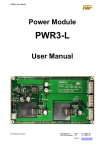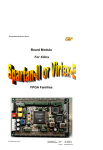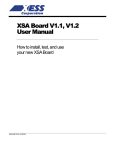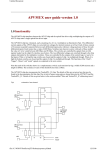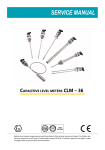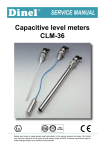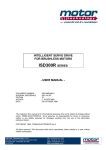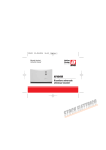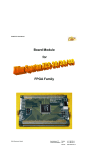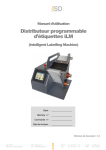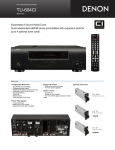Download User Manual - ErSt Electronic GmbH
Transcript
Power Module PWR3 User Manual User Manual ErSt Electronic GmbH Zürichstrasse 111 CH-8123 Ebmatingen Phone Fax +41 1 980 61 44 +41 1 980 61 30 Internet http://www.erst.ch PWR3 User Manual Manual Version: 2/12 PWR3 Version 1.0 July 1999 This manual describes the technical properties and the usage of the following products: Power Module PWR3 Version 1.0 July 1999 © ErSt Electronic GmbH, 1999 The ErSt Electronic GmbH reserves the right to make changes and improvements of the product without notice. Important Note: The power module PWR3 has been designed and tested exclusively for the usage as a development tool. In particular, strong electromagnetic radiation may be produced. The ErSt Electronic GmbH does not undertake any liability for damages which may result from an improper use of this product. ErSt Electronic GmbH Zürichstrasse 111 CH-8123 Ebmatingen Phone Fax +41 1 980 61 44 +41 1 980 61 30 Internet http://www.erst.ch PWR3 User Manual 3/12 Contents: 1 Introduction ................................................................................. 4 2 Overview....................................................................................... 5 3 2.1 Key Features...................................................................................5 2.2 Function Description .....................................................................7 Technical Information ................................................................ 8 3.1 Input Voltage..................................................................................9 3.2 Output Voltages .............................................................................9 3.3 Reference Voltages.......................................................................11 3.4 Indicator LEDs.............................................................................12 Figures: Figure 1: Block diagram of the power module PWR3 ............................................. 5 Figure 2: Component placement overview .............................................................. 8 Figure 3: Input protection circuit ............................................................................ 9 Figure 4: Reference voltage generation................................................................. 12 Tables: Table 1: Configuration of the output voltages ....................................................... 10 Table 2: Potentiometer for variable setting. .......................................................... 10 Table 3: Pin numbers and signals on the header connectors................................. 11 ErSt Electronic GmbH Zürichstrasse 111 CH-8123 Ebmatingen Phone Fax +41 1 980 61 44 +41 1 980 61 30 Internet http://www.erst.ch Power Module PWR3 User Manual 1 4/12 Introduction The ongoing miniaturisation of integrated circuits leads to lower supply voltages. This is due to two reasons. First, the dielectric streng of the insulator layers is limited. Second, the power dissipation can be minimised drastically (dynamic power dissipation is proportional to the square of the supply voltage). The commonly used technologies work with 5V and 3.3V where the structure size goes down to 0.35µm. Already today, 0.25µm processes are state of the art and in the future the semiconductor manufacturers will be able to work with 0.18µm and 0.13µm structure sizes. The supply voltages will follow this trend and reach 2.5V, 1.8V and 1.3V. Integrated circuits of different technologies with different supply voltages must work together in the same system. The implication of this is, that a single device can not longer work with a single supply voltage. Internal supplies and output driver supplies are separate from each other. The power module PWR3 generates three regulated voltages in the range of 1.3 to 5V to ease the use of future digital integrated circuits. In addition, eight reference voltages for the support of multistandard I/Os are provided. Information about new products and new developments can be found on the ErSt Electronic Website: http://www.erst.ch If you have questions you may write to the following email address: [email protected] We will answer as soon as possible, usually within one or two days. ErSt Electronic GmbH Zürichstrasse 111 CH-8123 Ebmatingen Phone Fax +41 1 980 61 44 +41 1 980 61 30 Internet http://www.erst.ch Power Module PWR3 User Manual 2 2.1 • • • • • • • • • • • • • 5/12 Overview Key Features Input power supply range 6-14V Switching regulator for VCCINT (1.8V/2.5V/3.3V/5V/Uvar) Switching regulator for VCCO (1.5V/2.5V/3.3V/5V/Uvar) Switching regulator for VCCOPT (1.8V/2.5V/3.3V/5V/Uvar) Output voltages selectable with jumper Uvar is user adjustable in the range 1.3-5.2V Switching regulators are protected against short circuits and thermal overload Max. 4A load current for all output voltages All output voltages available on header connectors and power connectors Output power sufficient for up to three board modules 6 reference voltages (0.75V, 0.8V, 1V, 1.125V, 1.32V and 1.5V) for 8 I/O banks selectable with DIP switch matrix May be stacked with EVALXCV Board size 86mm x 150mm Connector VREF 6 VCCO Select 1.8V/2.5V/3.3V/5V/Uvar Connector Select 1.8V/2.5V/3.3V/5V/Uvar VCCOPT Select 1.5V/2.5/3.3V/5V/Uvar DIP-Switch Matrix 8 Header Connector VCCINT Connector Power Supply 6-14V Figure 1: Block diagram of the power module PWR3 ErSt Electronic GmbH Zürichstrasse 111 CH-8123 Ebmatingen Phone Fax +41 1 980 61 44 +41 1 980 61 30 Internet http://www.erst.ch Power Module PWR3 User Manual 6/12 Absolute Maximum Ratings Symbol VIN IOUTVCCINT IOUTVCCO IOUTVCCOPT TSHORTOUT TSHORTREF TAMB Description 1) Input voltage 2) Output current for VCCINT 2) Output current for VCCO 2) Output current for VCCOPT Duration of output voltage short circuit 3) against ground Duration of reference voltage short circuit against ground 4) Ambient temperature Unit V A A A -0.3 ... 14 4 4 4 Continuous Continuous o 0 ... 70 C Note 1): The input is protected with an inverse diode and a transient suppressor diode. The inverse diode starts to conduct at voltages lower than –0.3V, the suppressor diode starts to conduct for voltages above 14V. Note 2): This is the maximal output current of the switching regulator. The regulator circuit is thermally and short circuits protected. Note 3): One output at a time. Note 4): The maximal possible output current is reduced at high ambient temperatures. Recommended Operating Conditions Symbol VIN IOUTVCCINT IOUTVCCO IOUTVCCOPT IOUTREF TAMB Note 1): Description Input voltage 1) Output current for VCCINT 1) Output current for VCCO 1) Output current for VCCOPT Output current of a reference voltage Ambient temperature 6 ... 12 3 3 3 10 0 ... 40 Unit V A A A mA o C Continuous operation without additional cooling at 25 oC. Typical Performance VIN = 10V, Ta = 25 oC unless otherwise noted Description Output ripple voltage (Vp-p) Quiscent current Efficiency Efficiency Efficiency ErSt Electronic GmbH Condition IOUT = 4A VOUT = 2.5V, IOUT = 4A VOUT = 3.3V, IOUT = 4A VOUT = 5V, IOUT = 4A Zürichstrasse 111 CH-8123 Ebmatingen 25 75 75 78 83 Unit mV mA % % % Phone Fax +41 1 980 61 44 +41 1 980 61 30 Internet http://www.erst.ch Power Module PWR3 User Manual 2.2 7/12 Function Description The power module PWR3 generates three regulated output voltages and eight reference voltages from a single unregulated power supply. The input supply voltage can be in the range from 6V to 14V. An inverse diode and a transient suppressor diode in conjunction with a fuse protect the module from inverted supply voltages and voltage transients. The output voltages are generated with switching regulators working with 500kHz operating frequency and having an output current capability of 4A. They are thermally and short circuit protected. All output voltages are configureable with jumpers. Four settings (5V, 3.3V, 2.5V and 1.8V resp. 1.5V) are fix, a fifth setting is adjustable with a trim potentiometer. The three output voltages are available on header and power connectors. Each of the power connectors allows the connection of four wires, two for ground and two for output power. Each of the eight reference voltages may be selected with DIP switches among six fixed voltages (0.75V, 0.8V, 1.0V, 1.125V, 1.32V and 1.5V). The reference voltages are also routed to the header connectors, buffered with a source follower. Four LEDs show the state of the three output voltages and the power supply. The three LEDs which correspond to the three output voltages are driven by operational amplifiers connected to the voltage feedback input of the switching regulators. The reason for this is, that the output voltage may be well below the minimal forward voltage of an LED. ErSt Electronic GmbH Zürichstrasse 111 CH-8123 Ebmatingen Phone Fax +41 1 980 61 44 +41 1 980 61 30 Internet http://www.erst.ch Power Module PWR3 User Manual 3 8/12 Technical Information VCCO 38 39 0.75V 0.80V 1.00V 1.125V 1.32V 1.50V 1 2 3 4 5 6 GND VCCINT 12 13 1 + Input Supply 6-12V GND VCCINT Selection Fuse 4A fast 1 2 3 4 5 6 VCCOPT Selection 1 2 3 4 5 6 adjust 1.8V 2.5V 3.3V 5V 1 2 3 4 5 6 VREF7 VREF5 VREF4 VREF6 50 + + GND VCCO Selection VCCO GND + + GND + + VCCINT GND GND GND 0.75V 0.80V 1.00V 1.125V 1.32V 1.50V VREF3 1 2 3 4 5 6 1 2 3 4 5 6 1 2 3 4 5 6 1 2 3 4 5 6 VREF2 VREF1 VREF0 25 12 13 GND 1 adjust 1.8V 2.5V 3.3V 5V VCCOPT 5V 3.3V 2.5V 1.5V adjust VREF 0 - 7 VCCOPT Figure 2 shows an overview of the placement of key components like input and output connectors, fuse, output voltage selection jumpers with adjustment potentiometers and DIP switches for reference voltage selection. A detailed description of each of these items is given in the following sections. Figure 2: Component placement overview ErSt Electronic GmbH Zürichstrasse 111 CH-8123 Ebmatingen Phone Fax +41 1 980 61 44 +41 1 980 61 30 Internet http://www.erst.ch Power Module PWR3 User Manual 3.1 9/12 Input Voltage The input voltage of the power module may be choosen in the range of 6V to 14V and is connected to a two pole power connector. An inverse diode and a transient suppressor diode in conjunction with a fuse protect the module. Caution: The fuse protects the module only in the case where the power supply can deliver enough current to blow the fuse immediately. Normally, inverse voltages or over voltages may be applied only for short durations to avoid damage to the module. Due to the function principle of switching regulators the input current is higher at low input voltages than at higher input voltages. It may be necessary to adjust the value of the fuse for certain operating conditions. Inverse Voltage Protection Overvoltage Protection D13 30BQ040 D11 SMCJ15A VPWR R65 510E F1 4A fast D12 KL1 Power Indicator 1 2 Input 6-14V Figure 3: Input protection circuit 3.2 Output Voltages The three ouput voltages are denoted with VCCINT, VCCO and VCCOPT. They are generated with switching regulators working at 500kHz. Each of the regulators is capable of delivering up to 4A and is thermally and short circuit protected. The value of each of the output voltages is selectable by a jumper. Table 1 shows the jumper settings and the resulting output voltage values. Only one jumper must be set at a time. During operation, the jumper settings may be changed without danger since the output voltage falls to 1.2V when all jumpers are removed. ErSt Electronic GmbH Zürichstrasse 111 CH-8123 Ebmatingen Phone Fax +41 1 980 61 44 +41 1 980 61 30 Internet http://www.erst.ch Power Module PWR3 User Manual Caution: 10/12 Never insert more than one jumper at the same time since the output voltage may then rise well above 5V, limited by the input voltage level only. Jumper J6 J7 J8 J9 J10 VCCINT 5V 3.3V 2.5V 1.8V variable Jumper J11 J12 J13 J14 J15 VCCO 5V 3.3V 2.5V 1.5V variable Jumper J1 J2 J3 J4 J5 VCCOPT 5V 3.3V 2.5V 1.8V variable Table 1: Configuration of the output voltages In the variable setting, the output voltages are adjustable with a trim potentiometer (see Table 2) in the range from 1.3V to 5.2V. Note: The factory settings of the variable output voltages is undefined and must be adjusted to a reasonable value by the user before connecting anything to the output! Potentiometer R19 R18 R17 Output voltage VCCINT VCCO VCCOPT Table 2: Potentiometer for variable setting. The output voltages are routed to power connectors and to header connectors. The naming and positioning of the signals on the header connectors corresponds with according connectors on board modules. Table 3 shows the pins and signals on the header connectors. Also refer to Figure 2. ErSt Electronic GmbH Zürichstrasse 111 CH-8123 Ebmatingen Phone Fax +41 1 980 61 44 +41 1 980 61 30 Internet http://www.erst.ch Power Module PWR3 User Manual Connector ST1 ST2 11/12 Pin Number 1 to 12 13 to 25 26 to 42 43 44 45 46 47 48 49 50 1 to 12 13 to 38 39 to 50 Signal Name VCCOPT GND Reserved VREF0 VREF1 VREF2 VREF3 VREF4 VREF5 VREF6 VREF7 VCCINT GND VCCO Table 3: Pin numbers and signals on the header connectors 3.3 Reference Voltages Figure 4 shows the circuit which generates the reference voltages. Eight reference voltages may be selected among six fixed voltages (0.75V, 0.8V, 1.0V, 1.125V, 1.32V und 1.5V) by means of DIP switches. All reference voltages are derived with resistive voltage dividers from a 2.5V reference. Note: Only one switch of each six position switch should be in the on position. If two or more switches are in the on position, the voltage dividers are connected in parallel and the reference voltage assumes a wrong value. The voltage dividers are buffered with an OpAmp (source follower). The output current of each reference voltage (VREF0 to VREF7) may be up to ca. 10mA. ErSt Electronic GmbH Zürichstrasse 111 CH-8123 Ebmatingen Phone Fax +41 1 980 61 44 +41 1 980 61 30 Internet http://www.erst.ch Power Module PWR3 User Manual 12/12 VPWR R59 510E 1.50V R53 1.5k 8 C27 0.47uF R54 56k 1.32V R51 2.2k 1.125V R55 22k R52 5.1k R46 2.2k R47 2.2k R66 5.6k 1.00V 0.80V R56 3.3k R13 5.1k 0.75V R57 56k R32 5.6k R58 56k D10 LM385M-2.5 4 R45 2.2k R48 2.2k R49 2.2k R50 2.2k R68 1M SW1 1 2 3 4 5 6 12 11 10 9 8 7 5 U1B LM324 7 VREF0 6 VPWR Bank0 to other banks Figure 4: Reference voltage generation 3.4 Indicator LEDs The three ouput voltages and the input voltage are equipped with indicator LEDs. The indicator LEDs of the output voltages are placed next to the appropriate power connector. As already mentioned in the function description, these LEDs are driven by an operational amplifier connected to the feedback voltage input of the switching regulator. The indicator LED of the input voltage is placed between the fuse and the transient suppressor diode. ErSt Electronic GmbH Zürichstrasse 111 CH-8123 Ebmatingen Phone Fax +41 1 980 61 44 +41 1 980 61 30 Internet http://www.erst.ch












